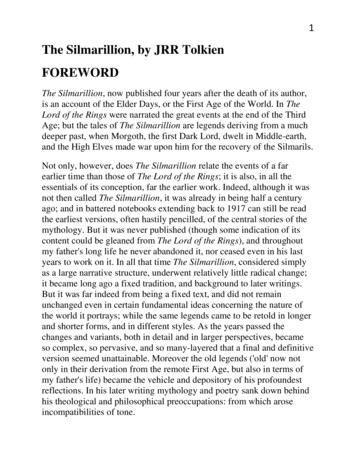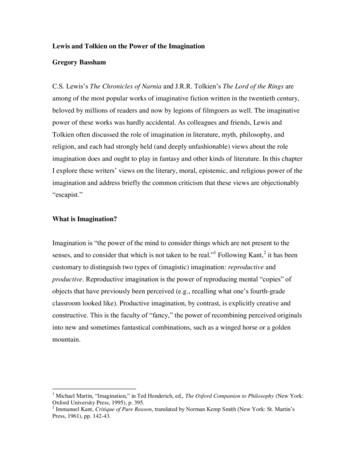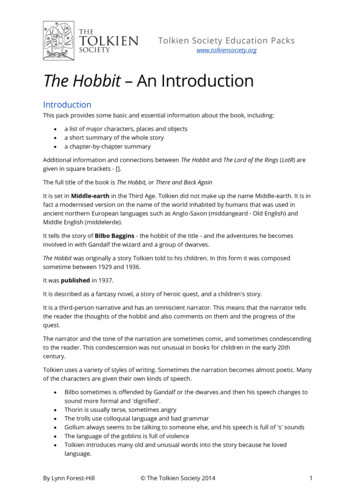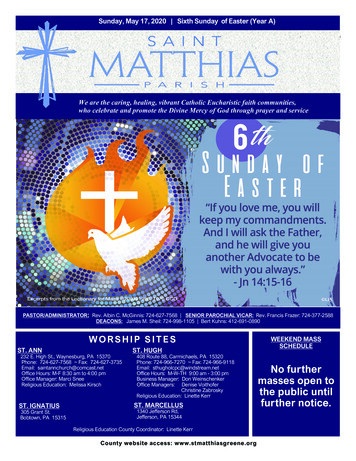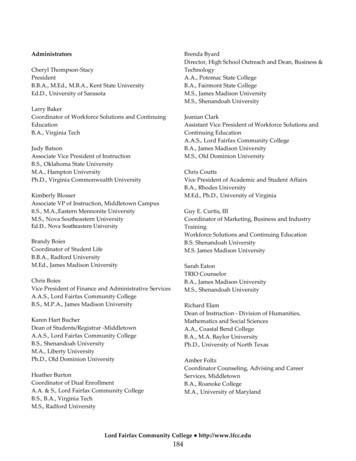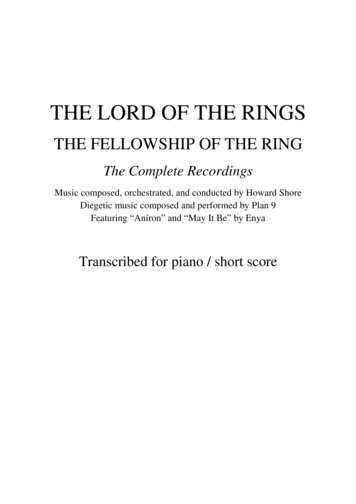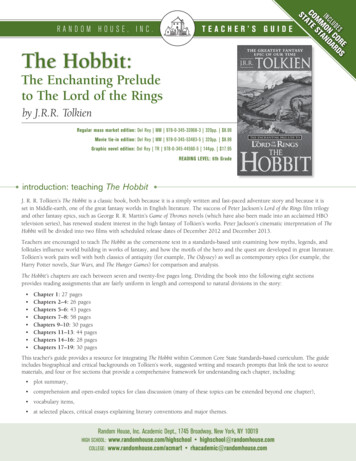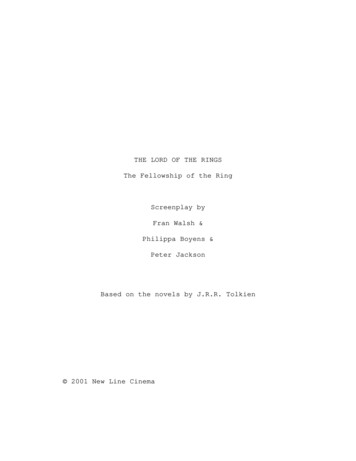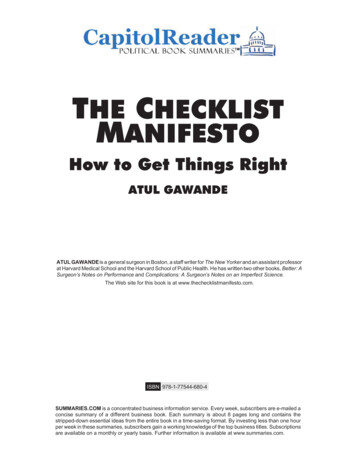
Transcription
J. R. R. Tolkien — The Lord Of The Rings. -THE LORD OF THE RINGSbyJ. R. R. TOLKIENPart 1: The Fellowship of the RingPart 2: The Two TowersPart 3: The Return of the KingComplete with Index and Full AppendicesThree Rings for the Elven-kings under the sky,Seven for the Dwarf-lords in their halls of stone,Nine for Mortal Men doomed to die,One for the Dark Lord on his dark throneIn the Land of Mordor where the Shadows lie.One Ring to rule them all, One Ring to find them,One Ring to bring them all and in the darkness bind themIn the Land of Mordor where the Shadows lie.CONTENTSFOREWORDPROLOGUE1.2.3.4.Concerning HobbitsConcerning Pipe-weedOf the Ordering of the ShireOf the Finding of the RingNote on the Shire recordsTHE FELLOWSHIP OF THE RINGBook ChapterChapterChapter1 A Long-expected Party2 The Shadow of the Past3 Three is Company4 A Short Cut to Mushrooms5 A Conspiracy Unmasked6 The Old Forest7 In the House of Tom Bombadil8 Fog on the Barrow-Downs9 At the Sign of The Prancing Pony10 Strider
Chapter 11 A Knife in the DarkChapter 12 Flight to the FordBook rChapterChapterChapter1 Many Meetings2 The Council of Elrond3 The Ring Goes South4 A Journey in the Dark5 The Bridge of Khazad-dûm6 Lothlórien7 The Mirror of Galadriel8 Farewell to Lórien9 The Great River10 The Breaking of the FellowshipTHE TWO TOWERSBook erChapterChapterChapterChapter1 The Departure of Boromir2 The Riders of Rohan3 The Uruk-Hai4 Treebeard5 The White Rider6 The King of the Golden Hall7 Helm's Deep8 The Road to Isengard9 Flotsam and Jetsam10 The Voice of Saruman11 The PalantýrBook rChapterChapterChapter1 The Taming of Sméagol2 The Passage of the Marshes3 The Black Gate is Closed4 Of Herbs and Stewed Rabbit5 The Window on the West6 The Forbidden Pool7 Journey to the Cross-roads8 The Stairs of Cirith Ungol9 Shelob's Lair10 The Choices of Master SamwiseTHE RETURN OF THE KINGBook ChapterChapter123456789Minas TirithThe Passing of the Grey CompanyThe Muster of RohanThe Siege of GondorThe Ride of the RohirrimThe Battle of the Pelennor FieldsThe Pyre of DenethorThe Houses of HealingThe Last Debate
Chapter 10 The Black Gate OpensBook rChapterChapter123456789The Tower of Cirith UngolThe Land of ShadowMount DoomThe Field of CormallenThe Steward and the KingMany PartingsHomeward BoundThe Scouring of the ShireThe Grey HavensAPPENDICESA ANNALS OF THE KINGS AND RULERSI The Númenorean Kings(I) Númenor(II) The Realms In Exile(III) Eriador, Arnor, and The Heirs Of Isildur(IV) Gondor and The Heirs Of Anñrion(V) Here Follows a Part of The Tale of Aragorn and ArwenII THE HOUSEOF EORLIII DURIN'S FOLKHere follows one of the last notes in the Red BookB THE TALE OF YEARS (CHRONOLOGY OF THE WESTLANDS)The Second AgeThe Third AgeC FAMILY TREESD CALENDARSSHIRE CALENDAR FOR USE IN ALL YEARSTHE CALENDARSE WRITING AND SPELLINGI Pronunciation of Words and NamesII WritingFI The Languages and Peoples of The Third AgeII On TranslationINDEXESI Songs and VersesII Persons, Beasts and MonstersIII PlacesIV Things
ORDThis tale grew in the telling, until it became a history of the Great War ofthe Ring and included many glimpses of the yet more ancient history thatpreceded it. It was begun soon after The Hobbit was written and before itspublication in 1937; but I did not go on with this sequel, for I wished firstto complete and set in order the mythology and legends of the Elder Days,which had then been taking shape for some years. I desired to do this for myown satisfaction, and I had little hope that other people would be interestedin this work, especially since it was primarily linguistic in inspiration andwas begun in order to provide the necessary background of 'history' for Elvishtongues.When those whose advice and opinion I sought corrected little hope tono hope, I went back to the sequel, encouraged by requests from readers formore information concerning hobbits and their adventures. But the story wasdrawn irresistibly towards the older world, and became an account, as it were,of its end and passing away before its beginning and middle had been told. Theprocess had begun in the writing of The Hobbit, in which there were alreadysome references to the older matter: Elrond, Gondolin, the High-elves, and theorcs, as well as glimpses that had arisen unbidden of things higher or deeperor darker than its surface: Durin, Moria, Gandalf, the Necromancer, the Ring.The discovery of the significance of these glimpses and of their relation tothe ancient histories revealed the Third Age and its culmination in the War ofthe Ring.Those who had asked for more information about hobbits eventually got it,but they had to wait a long time; for the composition of The Lord of theRings went on at intervals during the years 1936 to 1949, a period in which Ihad many duties that I did not neglect, and many other interests as a learnerand teacher that often absorbed me. The delay was, of course, also increasedby the outbreak of war in 1939, by the end of which year the tale had not yetreached the end of Book One. In spite of the darkness of the next five years Ifound that the story could not now be wholly abandoned, and I plodded on,mostly by night, till I stood by Balin's tomb in Moria. There I halted for along while. It was almost a year later when I went on and so came toLothlórien and the Great River late in 1941. In the next year I wrote thefirst drafts of the matter that now stands as Book Three, and the beginningsof chapters I and III of Book Five; and there as the beacons flared in Anórienand Théoden came to Harrowdale I stopped. Foresight had failed and there wasno time for thought.It was during 1944 that, leaving the loose ends and perplexities of a warwhich it was my task to conduct, or at least to report, 1 forced myself totackle the journey of Frodo to Mordor. These chapters, eventually to becomeBook Four, were written and sent out as a serial to my son, Christopher, thenin South Africa with the RAF. Nonetheless it took another five years beforethe tale was brought to its present end; in that time I changed my house, mychair, and my college, and the days though less dark were no less laborious.Then when the 'end' had at last been reached the whole story had to berevised, and indeed largely re-written backwards. And it had to be typed, andre-typed: by me; the cost of professional typing by the ten-fingered wasbeyond my means.The Lord of the Rings has been read by many people since it finallyappeared in print; and I should like to say something here with reference tothe many opinions or guesses that I have received or have read concerning themotives and meaning of the tale. The prime motive was the desire of a taleteller to try his hand at a really long story that would hold the attention ofreaders, amuse them, delight them, and at times maybe excite them or deeplymove them. As a guide I had only my own feelings for what is appealing or
moving, and for many the guide was inevitably often at fault. Some who haveread the book, or at any rate have reviewed it, have found it boring, absurd,or contemptible; and I have no cause to complain, since I have similaropinions of their works, or of the kinds of writing that they evidentlyprefer. But even from the points of view of many who have enjoyed my storythere is much that fails to please. It is perhaps not possible in a long taleto please everybody at all points, nor to displease everybody at the samepoints; for I find from the letters that I have received that the passages orchapters that are to some a blemish are all by others specially approved. Themost critical reader of all, myself, now finds many defects, minor and major,but being fortunately under no obligation either to review the book or towrite it again, he will pass over these in silence, except one that has beennoted by others: the book is too short.As for any inner meaning or 'message', it has in the intention of theauthor none. It is neither allegorical nor topical. As the story grew it putdown roots (into the past) and threw out unexpected branches: but its maintheme was settled from the outset by the inevitable choice of the Ring as thelink between it and The Hobbit. The crucial chapter, "The Shadow of thePast', is one of the oldest parts of the tale. It was written long before theforeshadow of 1939 had yet become a threat of inevitable disaster, and fromthat point the story would have developed along essentially the same lines, ifthat disaster had been averted. Its sources are things long before in mind, orin some cases already written, and little or nothing in it was modified by thewar that began in 1939 or its sequels.The real war does not resemble the legendary war in its process or itsconclusion. If it had inspired or directed the development of the legend, thencertainly the Ring would have been seized and used against Sauron; he wouldnot have been annihilated but enslaved, and Barad-dûr would not have beendestroyed but occupied. Saruman, failing to get possession of the Ring, wouldm the confusion and treacheries of the time have found in Mordor the missinglinks in his own researches into Ring-lore, and before long he would have madea Great Ring of his own with which to challenge the self-styled Ruler ofMiddle-earth. In that conflict both sides would have held hobbits in hatredand contempt: they would not long have survived even as slaves.Other arrangements could be devised according to the tastes or views ofthose who like allegory or topical reference. But I cordially dislike allegoryin all its manifestations, and always have done so since I grew old and waryenough to detect its presence. I much prefer history, true or feigned, withits varied applicability to the thought and experience of readers. I thinkthat many confuse 'applicability' with 'allegory'; but the one resides in thefreedom of the reader, and the other in the purposed domination of the author.An author cannot of course remain wholly unaffected by his experience,but the ways in which a story-germ uses the soil of experience are extremelycomplex, and attempts to define the process are at best guesses from evidencethat is inadequate and ambiguous. It is also false, though naturallyattractive, when the lives of an author and critic have overlapped, to supposethat the movements of thought or the events of times common to both werenecessarily the most powerful influences. One has indeed personally to comeunder the shadow of war to feel fully its oppression; but as the years go byit seems now often forgotten that to be caught in youth by 1914 was no lesshideous an experience than to be involved in 1939 and the following years. By1918 all but one of my close friends were dead. Or to take a less grievousmatter: it has been supposed by some that 'The Scouring of the Shire' reflectsthe situation in England at the time when I was finishing my tale. It doesnot. It is an essential part of the plot, foreseen from the outset, though inthe event modified by the character of Saruman as developed in the storywithout, need I say, any allegorical significance or contemporary politicalreference whatsoever. It has indeed some basis in experience, though slender(for the economic situation was entirely different), and much further back.The country in which I lived in childhood was being shabbily destroyed before
I was ten, in days when motor-cars were rare objects (I had never seen one)and men were still building suburban railways. Recently I saw in a paper apicture of the last decrepitude of the once thriving corn-mill beside its poolthat long ago seemed to me so important. I never liked the looks of the Youngmiller, but his father, the Old miller, had a black beard, and he was notnamed Sandyman.The Lord of the Rings is now issued in a new edition, and theopportunity has been taken of revising it. A number of errors andinconsistencies that still remained in the text have been corrected, and anattempt has been made to provide information on a few points which attentivereaders have raised. I have considered all their comments and enquiries, andif some seem to have been passed over that may be because I have failed tokeep my notes in order; but many enquiries could only be answered byadditional appendices, or indeed by the production of an accessory volumecontaining much of the material that I did not include in the originaledition, in particular more detailed linguistic information. In the meantimethis edition offers this Foreword, an addition to the Prologue, some notes,and an index of the names of persons and places. This index is in intentioncomplete in items but not in references, since for the present purpose it hasbeen necessary to reduce its bulk. A complete index, making full use of thematerial prepared for me by Mrs. N. Smith, belongs rather to the accessoryvolume.PROLOGUEThis book is largely concerned with Hobbits, and from its pages a reader maydiscover much of their character and a little of their history. Furtherinformation will also be found in the selection from the Red Book of Westmarchthat has already been published, under the title of The Hobbit . That storywas derived from the earlier chapters of the Red Book, composed by Bilbohimself, the first Hobbit to become famous in the world at large, and calledby him There and Back Again, since they told of his journey into the Eastand his return: an adventure which later involved all the Hobbits in the greatevents of that Age that are here related.Many, however, may wish to know more about this remarkable people fromthe outset, while some may not possess the earlier book. For such readers afew notes on the more important points are here collected from Hobbit-lore,and the first adventure is briefly recalled.Hobbits are an unobtrusive but very ancient people, more numerousformerly than they are today; for they love peace and quiet and good tilledearth: a well-ordered and well-farmed countryside was their favourite haunt.They do not and did not understand or like machines more complicated than aforge-bellows, a water-mill, or a hand-loom, though they were skilful withtools. Even in ancient days they were, as a rule, shy of 'the Big Folk', asthey call us, and now they avoid us with dismay and are becoming hard to find.They are quick of hearing and sharp-eyed, and though they are inclined to befat and do not hurry unnecessarily, they are nonetheless nimble and deft intheir movements. They possessed from the first the art of disappearing swiftlyand silently, when large folk whom they do not wish to meet come blunderingby; and this an they have developed until to Men it may seem magical. ButHobbits have never, in fact, studied magic of any kind, and their elusivenessis due solely to a professional skill that heredity and practice, and a closefriendship with the earth, have rendered inimitable by bigger and clumsierraces.For they are a little people, smaller than Dwarves: less tout and stocky,that is, even when they are not actually much shorter. Their height is
variable, ranging between two and four feet of our measure. They seldom nowreach three feet; but they hive dwindled, they say, and in ancient days theywere taller. According to the Red Book, Bandobras Took (Bullroarer), son ofIsengrim the Second, was four foot five and able to ride a horse. He wassurpassed in all Hobbit records only by two famous characters of old; but thatcurious matter is dealt with in this book.As for the Hobbits of the Shire, with whom these tales are concerned, inthe days of their peace and prosperity they were a merry folk. They dressed inbright colours, being notably fond of yellow and green; but they seldom woreshoes, since their feet had tough leathery soles and were clad in a thickcurling hair, much like the hair of their heads, which was commonly brown.Thus, the only craft little practised among them was shoe-making; but they hadlong and skilful fingers and could make many other useful and comely things.Their faces were as a rule good-natured rather than beautiful, broad, brighteyed, red-cheeked, with mouths apt to laughter, and to eating and drinking.And laugh they did, and eat, and drink, often and heartily, being fond ofsimple jests at all times, and of six meals a day (when they could get them).They were hospitable and delighted in parties, and in presents, which theygave away freely and eagerly accepted.It is plain indeed that in spite of later estrangement Hobbits arerelatives of ours: far nearer to us than Elves, or even than Dwarves. Of oldthey spoke the languages of Men, after their own fashion, and liked anddisliked much the same things as Men did. But what exactly our relationship iscan no longer be discovered. The beginning of Hobbits lies far back in theElder Days that are now lost and forgotten. Only the Elves still preserve anyrecords of that vanished time, and their traditions are concerned almostentirely with their own history, in which Men appear seldom and Hobbits arenot mentioned at all. Yet it is clear that Hobbits had, in fact, lived quietlyin Middle-earth for many long years before other folk became even aware ofthem. And the world being after all full of strange creatures beyond count,these little people seemed of very little importance. But in the days ofBilbo, and of Frodo his heir, they suddenly became, by no wish of their own,both important and renowned, and troubled the counsels of the Wise and theGreat.Those days, the Third Age of Middle-earth, are now long past, and theshape of all lands has been changed; but the regions in which Hobbits thenlived were doubtless the same as those in which they still linger: the NorthWest of the Old World, east of the Sea. Of their original home the Hobbits inBilbo's time preserved no knowledge. A love of learning (other thangenealogical lore) was far from general among them, but there remained still afew in the older families who studied their own books, and even gatheredreports of old times and distant lands from Elves, Dwarves, and Men. Their ownrecords began only after the settlement of the Shire, and their most ancientlegends hardly looked further back than their Wandering Days. It is clear,nonetheless, from these legends, and from the evidence of their peculiar wordsand customs, that like many other folk Hobbits had in the distant past movedwestward. Their earliest tales seem to glimpse a time when they dwelt in theupper vales of Anduin, between the eaves of Greenwood the Great and the MistyMountains. Why they later undertook the hard and perilous crossing of themountains into Eriador is no longer certain. Their own accounts speak of themultiplying of Men in the land, and of a shadow that fell on the forest, sothat it became darkened and its new name was Mirkwood.Before the crossing of the mountains the Hobbits had already becomedivided into three somewhat different breeds: Harfoots, Stoors, andFallohides. The Harfoots were browner of skin, smaller, and shorter, and theywere beardless and bootless; their hands and feet were neat and nimble; andthey preferred highlands and hillsides. The Stoors were broader, heavier inbuild; their feet and hands were larger, and they preferred flat lands andriversides. The Fallohides were fairer of skin and also of hair, and they were
taller and slimmer than the others; they were lovers of trees and ofwoodlands.The Harfoots had much to do with Dwarves in ancient times, and long livedin the foothills of the mountains. They moved westward early, and roamed overEriador as far as Weathertop while the others were still in the Wilderland.They were the most normal and representative variety of Hobbit, and far themost numerous. They were the most inclined to settle in one place, and longestpreserved their ancestral habit of living in tunnels and holes.The Stoors lingered long by the banks of the Great River Anduin, and wereless shy of Men. They came west after the Harfoots and followed the course ofthe Loudwater southwards; and there many of them long dwelt between Tharbadand the borders of Dunland before they moved north again.The Fallohides, the least numerous, were a northerly branch. They weremore friendly with Elves than the other Hobbits were, and had more skill inlanguage and song than in handicrafts; and of old they preferred hunting totilling. They crossed the mountains north of Rivendell and came down the RiverHoarwell. In Eriador they soon mingled with the other kinds that had precededthem, but being somewhat bolder and more adventurous, they were often found asleaders or chieftains among clans of Harfoots or Stoors. Even in Bilbo's timethe strong Fallohidish strain could still be noted among the greater families,such as the Tooks and the Masters of Buckland.In the westlands of Eriador, between the Misty Mountains and theMountains of Lune, the Hobbits found both Men and Elves. Indeed, a remnantstill dwelt there of the Dúnedain, the kings of Men that came over the Sea outof Westernesse; but they were dwindling fast and the lands of their NorthKingdom were falling far and wide into waste. There was room and to spare forincomers, and ere long the Hobbits began to settle in ordered communities.Most of their earlier settlements had long disappeared and been forgotten inBilbo's time; but one of the first to become important still endured, thoughreduced in size; this was at Bree and in the Chetwood that lay round about,some forty miles east of the Shire.It was in these early days, doubtless, that the Hobbits learned theirletters and began to write after the manner of the Dúnedain, who had in theirturn long before learned the art from the Elves. And in those days also theyforgot whatever languages they had used before, and spoke ever after theCommon Speech, the Westron as it was named, that was current through all thelands of the kings from Arnor to Gondor, and about all the coasts of the Seafrom Belfalas to Lune. Yet they kept a few words of their own, as well astheir own names of months and days, and a great store of personal names out ofthe past.About this time legend among the Hobbits first becomes history with areckoning of years. For it was in the one thousand six hundred and first yearof the Third Age that the Fallohide brothers, Marcho and Blanco, set out fromBree; and having obtained permission from the high king at Fornost, theycrossed the brown river Baranduin with a great following of Hobbits. Theypassed over the Bridge of Stonebows, that had been built in the days of thepower of the North Kingdom, and they took ail the land beyond to dwell in,between the river and the Far Downs. All that was demanded of them was thatthey should keep the Great Bridge in repair, and all other bridges and roads,speed the king's messengers, and acknowledge his lordship.Thus began the Shire-reckoning, for the year of the crossing of theBrandywine (as the Hobbits turned the name) became Year One of the Shire, andall later dates were reckoned from it. At once the western Hobbits fell inlove with their new land, and they remained there, and soon passed once moreout of the history of Men and of Elves. While there was still a king they werein name his subjects, but they were, in fact, ruled by their own chieftainsand meddled not at all with events in the world outside. To the last battle atFornost with the Witch-lord of Angmar they sent some bowmen to the aid of theking, or so they maintained, though no tales of Men record it. But in that warthe North Kingdom ended; and then the Hobbits took the land for their own, and
they chose from their own chiefs a Thain to hold the authority of the kingthat was gone. There for a thousand years they were little troubled by wars,and they prospered and multiplied after the Dark Plague (S.R. 37) until thedisaster of the Long Winter and the famine that followed it. Many thousandsthen perished, but the Days of Dearth (1158-60) were at the time of this talelong past and the Hobbits had again become accustomed to plenty. The land wasrich and kindly, and though it had long been deserted when they entered it, ithad before been well tilled, and there the king had once had many farms,cornlands, vineyards, and woods.Forty leagues it stretched from the Far Downs to the Brandywine Bridge,and fifty from the northern moors to the marshes in the south. The Hobbitsnamed it the Shire, as the region of the authority of their Thain, and adistrict of well-ordered business; and there in that pleasant comer of theworld they plied their well-ordered business of living, and they heeded lessand less the world outside where dark things moved, until they came to thinkthat peace and plenty were the rule in Middle-earth and the right of allsensible folk. They forgot or ignored what little they had ever known of theGuardians, and of the labours of those that made possible the long peace ofthe Shire. They were, in fact, sheltered, but they had ceased to remember it.At no time had Hobbits of any kind been warlike, and they had neverfought among themselves. In olden days they had, of course, been often obligedto fight to maintain themselves in a hard world; but in Bilbo's time that wasvery ancient history. The last battle, before this story opens, and indeed theonly one that had ever been fought within the borders of the Shire, was beyondliving memory: the Battle of Greenfields, S.R. 1147, in which Bandobras Tookrouted an invasion of Orcs. Even the weathers had grown milder, and the wolvesthat had once come ravening out of the North in bitter white winters were nowonly a grandfather's tale. So, though there was still some store of weapons inthe Shire, these were used mostly as trophies, hanging above hearths or onwalls, or gathered into the museum at Michel Delving. The Mathom-house it wascalled; for anything that Hobbits had no immediate use for, but were unwillingto throw away, they called a mathom . Their dwellings were apt to becomerather crowded with mathoms, and many of the presents that passed from hand tohand were of that son.Nonetheless, ease and peace had left this people still curiously tough.They were, if it came to it, difficult to daunt or to kill; and they were,perhaps, so unwearyingly fond of good things not least because they could,when put to it, do without them, and could survive rough handling by grief,foe, or weather in a way that astonished those who did not know them well andlooked no further than their bellies and their well-fed faces. Though slow toquarrel, and for sport killing nothing that lived, they were doughty at bay,and at need could still handle arms. They shot well with the bow, for theywere keen-eyed and sure at the mark. Not only with bows and arrows. If anyHobbit stooped for a stone, it was well to get quickly under cover, as alltrespassing beasts knew very well.All Hobbits had originally lived in holes in the ground, or so theybelieved, and in such dwellings they still felt most at home; but in thecourse of time they had been obliged to adopt other forms of abode. Actuallyin the Shire in Bilbo's days it was, as a rule, only the richest and thepoorest Hobbits that maintained the old custom. The poorest went on living inburrows of the most primitive kind, mere holes indeed, with only one window ornone; while the well-to-do still constructed more luxurious versions of thesimple diggings of old. But suitable sites for these large and ramifyingtunnels (or smials as they called them) were not everywhere to be found; andin the flats and the low-lying districts the Hobbits, as they multiplied,began to build above ground. Indeed, even in the hilly regions and the oldervillages, such as Hobbiton or Tuckborough, or in the chief township of theShire, Michel Delving on the White Downs, there were now many houses of wood,brick, or stone. These were specially favoured by millers, smiths, ropers, andcartwrights, and others of that sort; for even when they had holes to live in.
Hobbits had long been accustomed to build sheds and workshops.The habit of building farmhouses and barns was said to have begun amongthe inhabitants of the Marish down by the Brandywine. The Hobbits of thatquarter, the Eastfarthing, were rather large and heavy-legged, and they woredwarf-boots in muddy weather. But they were well known to be Stoors in a largepart of their blood, as indeed was shown by the down that many grew on theirchins. No Harfoot or Fallohide had any trace of a beard. Indeed, the folk ofthe Marish, and of Buckland, east of the River, which they afterwardsoccupied, came for the most part later into the Shire up from south-away; andthey still had many peculiar names and strange words not found elsewhere inthe Shire.It is probable that the craft of building, as many other crafts beside,was derived from the Dúnedain. But the Hobbits may have learned it direct fromthe Elves, the teachers of Men in their youth. For the Elves of the HighKindred had not yet forsaken Middle-earth, and they dwelt still at that timeat the Grey Havens away to the west, and in other places within reach of theShire. Three Elf-towers of immemorial age were still to be seen on the TowerHills beyond the western marches. They shone far off in the moonlight. Thetallest was furthest away, standing alone upon a green mound. The Hobbits ofthe Westfarthing said that one could see the Sea from the lop of that tower;but no Hobbit had ever been known to climb it. Indeed, few Hobbits had everseen or sailed upon the Sea, and fewer still had ever returned to report it.Most Hobbits regarded even rivers and small boats with deep misgivings, andnot many of them could swim. And as the days of the Shire lengthe
Book II Chapter 1 Many Meetings Chapter 2 The Council of Elrond Chapter 3 The Ring Goes South Chapter 4 A Journey in the Dark Chapter 5 The Bridge of Khazad-dûm Chapter 6 Lothlórien Chapter 7 The Mirror of Galadriel Chapter 8 Farewell to Lórien Chapter 9 The Great River Chapter 10 The Breaking o
